Deep Structure of Nanling-Xuancheng Ore District, Eastern China: Insights from Integrated Geophysical Exploration
Abstract
:1. Introduction
2. Geological Setting
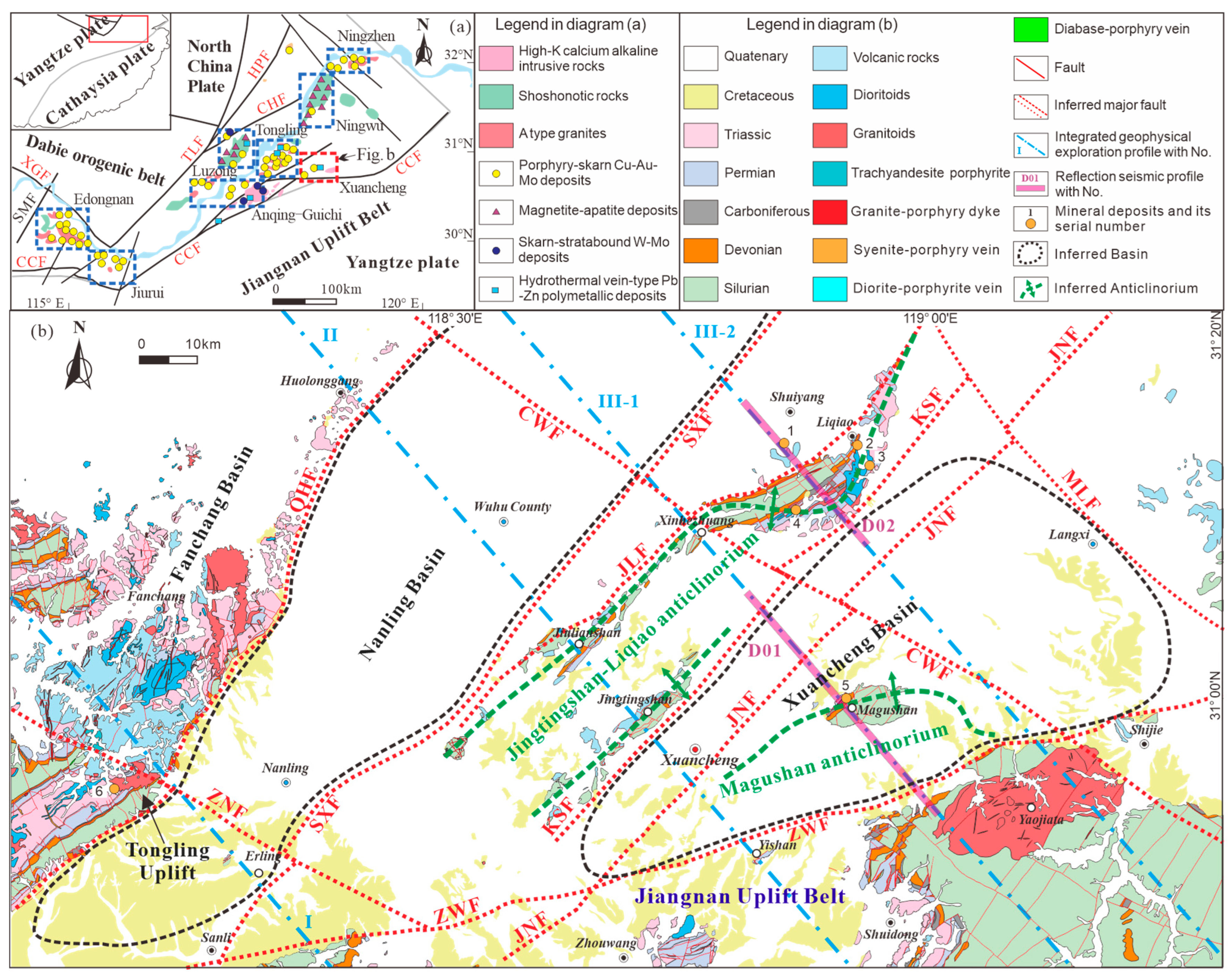
3. Data Collection and Processing
3.1. Integrated Geophysical Exploration Strategy
3.2. Seismic Reflection Data
- Defining Spatial Attributes
- Tomographic Static Correction
- Pre-stack Noise Suppression
- Amplitude Recovery and Compensation
- Deconvolution
- Velocity Analysis
- Residual Static Correction
- Migration Imaging
3.3. MT Data
3.4. Gravity and Magnetic Data
3.5. Petrophysics Data
- Quaternary loose sediments. Mainly distributed in Nanling Basin and Xuancheng Basin, there are also sporadic distributions in valleys and foothills, characterized by low density, weak magnetism, and low resistance.
- Paleogene-Late Cretaceous clastic rocks. Mainly distributed on the south side of Nanling Basin, there are also sporadic distributions in valleys and foothills, characterized by medium-low density, weak magnetism, and low resistance.
- Early Cretaceous volcanic clastic rocks and tuff. Mainly distributed in Fanchang Volcanic Rock Basin, on both sides of Jingtingshan-Liqiao Anticline at the transition part of the basin. The magnetism varies greatly according to the content of volcanic debris, generally characterized by low density, medium-low magnetism, and secondary low resistance.
- Mesozoic igneous rocks. Due to the large difference in dark mineral content, density values range from medium-high to medium-low. The changes in magnetism and resistivity are also large. The overall physical property changes are wide and appear chaotic. Using magnetism as the main indicator, Mesozoic igneous rocks can be divided into three types: The first type is intermediate intrusive rock bodies with medium-strong magnetism containing more magnetic minerals such as syenite gneiss, gneiss porphyry, quartz diorite, granodiorite, diorite etc. The second type is intermediate-felsic intrusive rocks with weak magnetism and few magnetic minerals mainly composed of quartz and feldspar such as granophyre porphyry orthoclase porphyry biotite granite potassium feldspar granite etc. The third type is subvolcanic rocks with unstable magnetism such as coarse porphyry etc.
- Triassic limestone. Mainly distributed in uplifted areas and outer edges of basins generally characterized by medium-high density low magnetism high resistance.
- Middle-Late Permian clastic rocks. Mainly distributed in uplifted areas and outer edges of basins generally characterized by medium-low density low magnetism medium-low resistance.
- Early Permian-Carboniferous limestone. Mainly distributed in Maoshan Mountain Range outer edge of Daibu Volcanic Rock Basin generally characterized by medium-high density weak magnetism high resistance.
- Devonian-Silurian clastic rocks. The lower Yangtze stratigraphic zone is mainly distributed in Jingtingshan-Liqiao Anticline Tongling Uplift with rock types mainly carbonate rocks and shale overall characterized by high density weak magnetism high resistance; Jiangnan stratigraphic zone is distributed in Magushan Inverted Anticline area with rock types mainly mudstone shale overall characterized by medium density weak magnetism high resistance.
4. 2.5D Modeling Method
4.1. Integration of Multiple Prior Information
4.2. Establishment of Initial Model
4.3. Joint Interpretation of Gravity, Magnetic, MT and Seismic Data
4.4. The 2.5D Interactive Modeling Workflow
- Establish the Initial Model
- Modeling Unit Division
- Single Method Inversion and Interpretation
- Correction of Initial Model
- Iterative modification
5. Results and Interpretation
5.1. Integrated Profile I
5.1.1. Fanchang Basin
5.1.2. Tongling Uplift
5.1.3. Nanling Basin
5.2. Integrated Profile II
5.2.1. Nanling Basin
5.2.2. Jingtingshan-Liqiao Anticlinorium
5.3. Integrated Profile III-1
5.3.1. Jingtingshan-Liqiao Anticlinorium
5.3.2. Xuancheng Basin
5.3.3. Magushan Anticlinorium
5.4. Integrated Profile III-2
5.4.1. Jingtingshan-Liqiao Anticlinorium (Chating Deposit)
5.4.2. Yaojiata Syenogranite
6. Discussion
6.1. Structure
6.2. Fault Network
- Qingshuihe-Hewan Fault (QHF)
- Sanli-Xihe Fault (SXF)
- Jiangnan Fault (JNF)
- Jiulianshan-Liqiao Fault (JLF)
- Kunshan Fault (KSF)
- Zhouwang Fault (ZWF)
- Zhongming-Nanling Fault (ZNF)
6.3. Concealed Magmatic Rocks
- Tongling-Fanchang
- Xuancheng
- Yaojiata
7. Conclusions
Author Contributions
Funding
Data Availability Statement
Acknowledgments
Conflicts of Interest
Appendix A
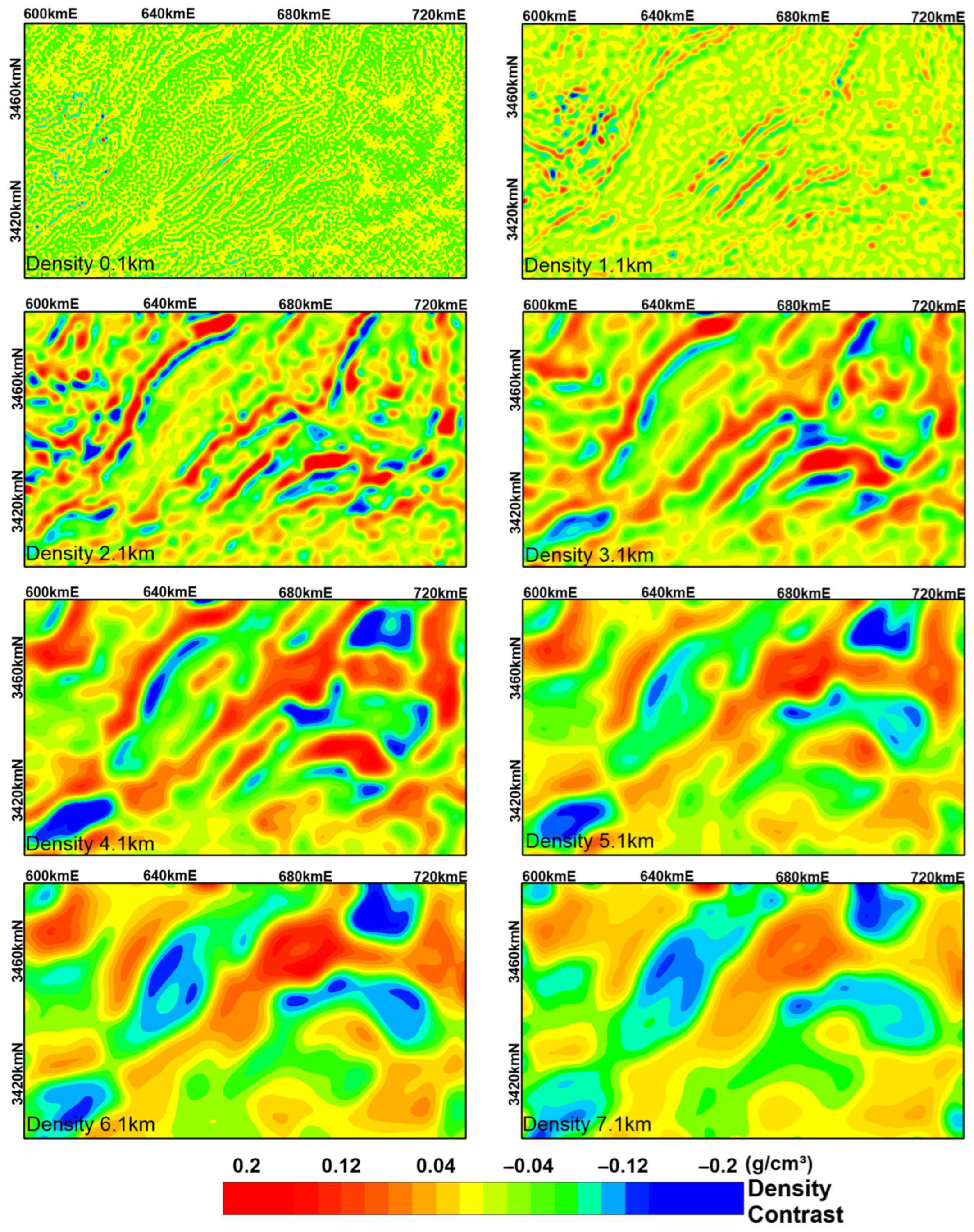

References
- Zhou, T.; Wang, S.; Fan, Y.; Yuan, F.; Zhang, D.; White, N.C. A review of the intracontinental porphyry deposits in the Middle-Lower Yangtze River Valley metallogenic belt, Eastern China. Ore Geol. Rev. 2015, 65, 433–456. [Google Scholar] [CrossRef]
- Pirajno, F.; Zhou, T. Intracontinental Porphyry and Porphyry-Skarn Mineral Systems in Eastern China: Scrutiny of a Special Case “Made-in-China”. Econ. Geol. 2015, 110, 603–629. [Google Scholar] [CrossRef]
- Zhou, T.; Fan, Y.; Chen, J.; Xiao, X.; Zhang, S. Critical metal resources in the Middle-Lower Yangtze River Valley metallogenic belt. Chin. Sci. Bull. 2020, 65, 3665–3677, (In Chinese with English Abstract). [Google Scholar] [CrossRef]
- Lu, S.; Zhang, Z.; Zhao, L.; Li, J.; Zhao, Z.; Qi, H. Genetic Types, Spatial-temporal Distribution of Ore Deposits and Sources of Ore-forming Materials in the Xuancheng Area, Anhui Province. Acta Geol. Sin.—Engl. Ed. 2020, 94, 1874–1892. [Google Scholar] [CrossRef]
- Qi, H.; Lu, S.; Yang, X.; Zhao, L.; Zhou, Y.; Deng, J.; Li, J. Genesis of Cretaceous igneous rocks and its related large scale porphyry Cu-Au mineralization in Chating, the Middle-Lower Yangtze River Metallogenic Belt: The geochemical constrains. Ore Geol. Rev. 2020, 127, 103793. [Google Scholar] [CrossRef]
- Jiang, F.; Xu, X.; Wang, M.; Huang, M.; Fan, Z.; He, J. The characteristics and diagenetic age magmatic rocks of the Chating porphyry copper-gold deposit, Xuancheng City, Anhui Province. Acta Geol. Sin. 2015, 89, 144–147, (In Chinese with English Abstract). [Google Scholar]
- Wang, Y.; Jiang, C.; Zhou, Y.; Du, H.; Bai, Q. Field structural characteristics of Zhouwang Fault and implications for its formation and evolution. J. Hefei Univ. Technol. Nat. Sci. 2022, 45, 813–817, (In Chinese with English Abstract). [Google Scholar]
- Xie, Q.; Sun, R.; Xu, X.; Xu, X.; An, Y.; Qian, S. Characteristics of Cryptoexplosive Breccia from the Chating Copper-Gold Deposits, Xuancheng, Anhui Province and Its Metallogenic Significance. Geol. J. China Univ. 2020, 26, 255–264, (In Chinese with English Abstract). [Google Scholar]
- Xiao, Q.-L.; Zhou, T.-F.; Wang, S.-W.; Yuan, F.; White, N.C.; Wang, F.-Y.; Xie, Z.-J.; Liu, J. Genesis of Chating Cu-Au deposit in the Middle-Lower Yangtze River Metallogenic Belt, Eastern China: Implications from magnetite and biotite geochemistry. Ore Geol. Rev. 2019, 106, 113–133. [Google Scholar] [CrossRef]
- Hu, X.; Li, X.; Yuan, F.; Ord, A.; Jowitt, S.M.; Li, Y.; Dai, W.; Zhou, T. Numerical modeling of ore-forming processes within the Chating Cu-Au porphyry-type deposit, China: Implications for the longevity of hydrothermal systems and potential uses in mineral exploration. Ore Geol. Rev. 2020, 116, 103230. [Google Scholar] [CrossRef]
- Meng, F.; Li, X.; Chen, Y.; Ye, R.; Yuan, F. Three-Dimensional Mineral Prospectivity Modeling for Delineation of Deep-Seated Skarn-Type Mineralization in Xuancheng–Magushan Area, China. Minerals 2022, 12, 1174. [Google Scholar] [CrossRef]
- Zhou, Y.; Li, L.; Yang, K.; Xing, G.; Xiao, W.; Zhang, H.; Xiu, L.; Yao, Z.; Xie, Z. Hydrothermal alteration characteristics of the Chating Cu-Au deposit in Xuancheng City, Anhui Province, China: Significance of sericite alteration for Cu-Au exploration. Ore Geol. Rev. 2020, 127, 103844. [Google Scholar] [CrossRef]
- Zhdanov, M.S. Editorial for Special Issue “Geophysics for Mineral Exploration”. Minerals 2021, 11, 692. [Google Scholar] [CrossRef]
- Schodde, R. Challenges and opportunities for geophysics for making discoveries under cover. In Proceedings of the PDAC Convention, Toronto, ON, Canada, 3–6 March 2020. [Google Scholar]
- Witherly, K. Exploration geophysics: Past performance and future opportunities. Preview 2020, 207, 11–14. [Google Scholar] [CrossRef]
- Tichauer, R.; Martins, A.C.; Silva, R.S.; de Tomi, G. The role of geophysics in enhancing mine planning decision-making in small-scale mining. R. Soc. Open Sci. 2020, 7, 200384. [Google Scholar] [CrossRef] [PubMed]
- Goodway, B. Introduction to this special section: Mining geophysics. Lead. Edge 2012, 31, 288–290. [Google Scholar] [CrossRef]
- Witherly, K. The evolution of minerals exploration over 60 years and the imperative to explore undercover. Lead. Edge 2012, 31, 292–295. [Google Scholar] [CrossRef]
- Lü, Q.; Liu, Z.; Yan, J.; Tang, J.; Wu, M.; Xiao, X. Crustal-scale structure and deformation of Lu-Zong ore district: Joint interpretation from integrated geophysical data. Interpretation 2015, 3, SL39–SL61. [Google Scholar] [CrossRef]
- Kamm, J.; Lundin, I.A.; Bastani, M.; Sadeghi, M.; Pedersen, L.B. Joint inversion of gravity, magnetic, and petrophysical data—A case study from a gabbro intrusion in Boden, Sweden. Geophysics 2015, 80, B131–B152. [Google Scholar] [CrossRef]
- Lelièvre, P.G.; Farquharson, C.G. Integrated Imaging for Mineral Exploration. In Integrated Imaging of the Earth; Moorkamp, M., Lelièvre, P., Eds.; John Wiley & Sons: Hoboken, NJ, USA, 2016; pp. 137–166. [Google Scholar]
- Oldenburg, D.W.; Pratt, D.A. Geophysical inversion for mineral exploration: A decade of progress in theory and practice. In Proceedings of the Exploration 07: Fifth Decennial International Conference on Mineral Exploration, Toronto, ON, Canada, 9–12 September 2007. [Google Scholar]
- Li, Y.; Melo, A.; Martinez, C.; Sun, J. Geology differentiation: A new frontier in quantitative geophysical interpretation in mineral exploration. Lead. Edge 2019, 38, 60–66. [Google Scholar] [CrossRef]
- Dong, S.; Li, T.; Chen, X.; Gao, R.; Lü, Q.; Shi, Y.; Huang, D.; Yang, J.; Wang, X.; Wei, W.; et al. SinoProbe revealed crustal structures, deep processes, and metallogenic background within China continent. Earth Sci. Front. 2014, 21, 201–225. [Google Scholar]
- Chang, Y.; Li, J.; Song, C. The regional tectonic framework and some new understandings of the Middle-Lower Yangtze River Valley Metallogenic Belt. Acta Petrol. Sin. 2019, 35, 3579–3591, (In Chinese with English Abstract). [Google Scholar]
- Liu, G.; Dong, S.; Ma, L.; Cui, J.; Xue, H.; Shi, W.; Li, J.; Huang, S. Basement and Metallogeny Belt of the Middle-Lower Yangtze River, Eastern China. Acta Geol. Sin. 2016, 90, 2258–2275, (In Chinese with English Abstract). [Google Scholar]
- Lü, Q.; Meng, G.; Zhang, K.; Liu, Z.; Yan, J.; Shi, D.; Han, J.; Gong, X. The lithospheric architecture of the Lower Yangtze Metallogenic Belt, East China: Insights into an extensive Fe–Cu mineral system. Ore Geol. Rev. 2021, 132, 103989. [Google Scholar] [CrossRef]
- Dong, S.; Ma, L.; Liu, G.; Xue, H.; Shi, W.; Li, J. On Dynamics of the Metallogenic Belt of Middle-Lower Reaches of Yangtze River, Eastern China. Acta Geol. Sin. 2011, 85, 612–625, (In Chinese with English Abstract). [Google Scholar]
- Dong, S.; Zhang, Y.; Zhang, F.; Cui, J.; Chen, X.; Zhang, S.; Miao, L.; Li, J.; Shi, W.; Li, Z.; et al. Late Jurassic–Early Cretaceous continental convergence and intracontinental orogenesis in East Asia: A synthesis of the Yanshan Revolution. J. Asian Earth Sci. 2015, 114, 750–770. [Google Scholar] [CrossRef]
- Zhu, G.; Liu, C.; Gu, C.; Zhang, S.; Li, Y.; Su, N.; Xiao, S. Oceanic plate subduction history in the western Pacific Ocean: Constraint from late Mesozoic evolution of the Tan-Lu Fault Zone. Sci. China Earth Sci. 2018, 61, 386–405. [Google Scholar] [CrossRef]
- Song, C.; Zhou, T.; Yan, J.; Ren, S.; Li, J.; Tu, W.; Zhang, Y. Mesozoic tectonic regime transition of the Middle and Lower Reaches of the Yangtze River and its adjacent area. Acta Petrol. Sin. 2010, 26, 2835–2849, (In Chinese with English Abstract). [Google Scholar]
- Dong, S.; Zhang, Y.; Li, H.; Shi, W.; Xue, H.; Li, J.; Huang, S.; Wang, Y. The Yanshan orogeny and late Mesozoic multi-plate convergence in East Asia—Commemorating 90th years of the “Yanshan Orogeny”. Sci. China Earth Sci. 2018, 61, 1888–1909. [Google Scholar] [CrossRef]
- Lu, S.; Lan, X.; Zhao, L.; Zhang, Z.; Yang, X.; Zhao, Z.; Guo, D.; Xu, X.; Wang, Y.; Li, J.; et al. A 3D Investigation of Geological Structure and Its Relationship to Mineralization in the Nanling-Xuancheng Ore District, Middle-Lower Yangtze River Metallogenic Belt. China. J. Earth Sci 2022, 33, 664–680. [Google Scholar] [CrossRef]
- Groves, D.I.; Santosh, M.; Zhang, L. A scale-integrated exploration model for orogenic gold deposits based on a mineral system approach. Geosci. Front. 2020, 11, 719–738. [Google Scholar] [CrossRef]
- Gallardo, L.A.; Fontes, S.L.; Meju, M.A.; Buonora, M.P.; de Lugao, P.P. Robust geophysical integration through structure-coupled joint inversion and multispectral fusion of seismic reflection, magnetotelluric, magnetic, and gravity images: Example from Santos Basin, offshore Brazil. Geophysics 2012, 77, B237–B251. [Google Scholar] [CrossRef]
- Malehmir, A.; Bellefleur, G. 3D seismic reflection imaging of volcanic-hosted massive sulfide deposits: Insights from reprocessing Halfmile Lake data, New Brunswick, Canada. Geophysics 2009, 74, B209–B219. [Google Scholar] [CrossRef]
- Goodfellow, W.D. Mineral Deposits of Canada: A Synthesis of Major Deposit Types, District Metallogeny, the Evolution of Geological Provinces, and Exploration Methods; Geological Association of Canada, Mineral Deposits Division: St. John’s, NL, USA, 2007. [Google Scholar]
- Goleby, B.R.; Huston, D.L.; Lyons, P.; Vandenberg, L.; Bagas, L.; Davies, B.M.; Jones, L.E.; Gebre-Mariam, M.; Johnson, W.; Smith, T.; et al. The Tanami deep seismic reflection experiment: An insight into gold mineralization and Paleoproterozoic collision in the North Australian Craton. Tectonophysics 2009, 472, 169–182. [Google Scholar] [CrossRef]
- DZ/T 0173-1997; Technical Regulations for MT Sounding. The Fifth Geological Survey Office of the Physical Exploration Bureau of China National Petroleum Corporation, Ministry of Geology and Mineral Resources of P.R. China: Beijing, China, 1997. (In Chinese)
- Bibby, H.M.; Caldwell, T.G.; Brown, C. Determinable and non-determinable parameters of galvanic distortion in magnetotellurics. Geophys. J. Int. 2005, 163, 915–930. [Google Scholar] [CrossRef]
- You, M.; Guo, D.; Lan, X.; Yang, X.; Wang, Q.; Wu, X. 3-D Magnetotelluric Resistivity Imaging of Nanling-Xuancheng Ore Concentration Area. IEEE Access 2021, 9, 68332–68342. [Google Scholar] [CrossRef]
- Zhang, K.; Wei, W.; Lu, Q. Four changes for efficiency and practicality on previous 3D MT NLCG inversion algorithm. Acta Geod Geophys 2014, 49, 551–563. [Google Scholar] [CrossRef]
- Zhang, K.; Yan, J.; Lü, Q.; Zhao, J.; Hu, H. Three-dimensional nonlinear conjugate gradient parallel inversion with full information of marine magnetotellurics. J. Appl. Geophys. 2017, 139, 144–157. [Google Scholar] [CrossRef]
- Zhang, K.; LÜ, Q.; Lan, X.; Guo, D.; Wang, Q.; Yan, J.; Zhao, J. Magnetotelluric evidence for crustal decoupling: Insights into tectonic controls on the magmatic mineral system in the Nanling–Xuancheng area, SE China. Ore Geol. Rev. 2021, 131, 104045. [Google Scholar] [CrossRef]
- Liu, D. Decreasing radiative method for regional separation of potential field data. Chin. J. Geophys. 2017, 60, 3215–3228, (In Chinese with English Abstract). [Google Scholar]
- Liu, D.; Hong, T.; Jia, Z.; Li, J.; Lu, S.; Sun, X.; Xu, S. Wave number domain iteration method for downward continuation of potential fields and its convergence. Chin. J. Geophys. 2009, 52, 1599–1605, (In Chinese with English Abstract). [Google Scholar]
- Dentith, M.; Mudge, S.T. Geophysics for the Mineral Exploration Geoscientist; Cambridge University Press: New York, NY, USA, 2018. [Google Scholar]
- Dentith, M.; Enkin, R.J.; Morris, W.; Adams, C.; Bourne, B. Petrophysics and mineral exploration: A workflow for data analysis and a new interpretation framework. Geophys. Prospect. 2020, 68, 178–199. [Google Scholar] [CrossRef]
- Pueyo, E.L.; Ayala, C.; Izquierdo-Llavall, E.; Rubio, F.M.; Santolaria, P.; Clariana, P.; Soto, R.; Müller, C.O.; Rey-Moral, C.; Zehner, B.; et al. Optimized 3D Reconstruction Workflow Based on Gravimetric, Structural and Petrophysical Data. Deliverable 6.4. Project 3dgeo-EU, Geoera- 3D Geomodeling for Europe, Project Number GeoE.171.005. Report. 2021. 264p. Available online: https://geoera.eu/wp-content/uploads/2022/01/3DGEO-EU_D8.5_Summary-of-project-work-and-results.pdf (accessed on 14 January 2022).
- Persson, L.; Lundin, I.A.; Pedersen, L.B.; Claeson, D. Combined magnetic, electromagnetic and resistivity study over a highly conductive formation in Orrivaara, Northern Sweden. Geophys. Prospect. 2011, 59, 1155–1163. [Google Scholar] [CrossRef]
- DZ/T 0368-2021; Technical Specifications for the Petrophysical Measurement by Specimen. Institute of Geophysical and Geochemical Exploration, Chinese Academy of Geological Sciences, Ministry of Natural Resource of the People’s Republic of China: Beijing, China, 2021. (In Chinese)
- Jorgensen, M.; Zhdanov, M. Recovering Magnetization of Rock Formations by Jointly Inverting Airborne Gravity Gradiometry and Total Magnetic Intensity Data. Minerals 2021, 11, 366. [Google Scholar] [CrossRef]
- Pratt, D.; McKenzie, K.B. Maximising geological information recovery from different magnetic instruments through the application of joint inversion. ASEG Ext. Abstr. 2009, 2009, 1–13. [Google Scholar] [CrossRef]
- Cole, J.; Finn, C.A.; Webb, S.J. Geometry of the Bushveld Complex from 3D potential field modelling. Precambrian Res. 2021, 359, 106219. [Google Scholar] [CrossRef]
- Lelièvre, P.G.; Farquharson, C.G.; Hurich, C.A. Joint inversion of seismic traveltimes and gravity data on unstructured grids with application to mineral exploration. Geophysics 2012, 77, K1–K15. [Google Scholar] [CrossRef]
- Oldenburg, D.W.; Li, Y.; Ellis, R.G. Inversion of geophysical data over a copper gold porphyry deposit: A case history for Mt. Milligan. Geophysics 1997, 62, 1419–1431. [Google Scholar] [CrossRef]
- García Juanatey, M.d.l.Á.; Tryggvason, A.; Juhlin, C.; Bergström, U.; Hübert, J.; Pedersen, L.B. MT and reflection seismics in northwestern Skellefte Ore District, Sweden. Geophysics 2013, 78, B65–B76. [Google Scholar] [CrossRef]
- Eric, M.; Takam, T.; Brett, H.; Anton, K.; Le Cuong, V.A. Cooperative joint inversion of 3D seismic and magnetotelluric data: With application in a mineral province. Geophysics 2015, 80, R175–R187. [Google Scholar]
- Bosch, M.; McGaughey, J. Joint inversion of gravity and magnetic data under lithologic constraints. Geophysics 2001, 20, 877–881. [Google Scholar] [CrossRef]
- Cady, J.W. Calculation of gravity and magnetic anomalies of finite-length right polygonal prisms. Geophysics 1980, 45, 1507–1512. [Google Scholar] [CrossRef]
- Clark, D.A.; Saul, S.J.; Emerson, D.W. Magnetic and gravity anomalies of a triaxial ellipsoid. Explor. Geophys. 1986, 17, 189–200. [Google Scholar] [CrossRef]
- Yao, C.; Guan, Z. Computation of magnetic gradients due to three-dimensional bodies. Sci. China Ser. D-Earth Sci. 1997, 40, 293–299. [Google Scholar] [CrossRef]
- Zhang, M. RGIS for Gravity Magnetic and Electric Data Processing; Geology Press: Beijing China, 2011; (In Chinese with English Abstract). [Google Scholar]
- Malehmir, A.; Thunehed, H.; Tryggvason, A. The Paleoproterozoic Kristineberg mining area, northern Sweden: Results from integrated 3D geophysical and geologic modeling, and implications for targeting ore deposits. Geophysics 2009, 74, B9–B22. [Google Scholar] [CrossRef]
- Lan, X.; Du, J.; Yan, j.; An, M.; Wan, Q.; Guo, D.; Liao, M.; Wang, Y.; Tao, L.; Zhang, Q.; et al. 3D gravity and magnetic interactive inversion modeling based on prior information: A case study of the Tongling ore concentration area. Chin. J. Geophys. 2015, 12, 4436–4449, (In Chinese with English Abstract). [Google Scholar]
- Lü, Q.; Qi, G.; Yan, J. 3D geologic model of Shizishan ore field constrained by gravity and magnetic interactive modeling: A case history. Geophysics 2013, 78, B25–B35. [Google Scholar] [CrossRef]
- Bosch, M. Lithologic tomography: From plural geophysical data to lithology estimation. J. Geophys. Res. 1999, 104, 749–766. [Google Scholar] [CrossRef]
- Williams, N.C. Geologically-Constrained UBC–GIF Gravity and Magnetic Inversions with Examples from the Agnew-Wiluna Greenstone Belt, Western Australia; University of British Columbia: Vancouver, BC, Canada, 2008; pp. 31–35. [Google Scholar]
- Tarantola, A. Inverse Problem Theory and Methods for Model Parameter Estimation; Society for Industrial and Applied Mathematics: Philadelphia, PA, USA, 2005. [Google Scholar]
- Zhou, W.; Yan, J.; Chen, C. The Terminal of Mineral System Exploration in Thick Coverage Area by Gravity and Magnetic Data—A Case Study on the Nihe Iron Deposit. Acta Geol. Sin.—Engl. Ed. 2021, 95, 118–120. [Google Scholar] [CrossRef]
- Wu, C.; Dong, S.; Wang, L.; Wang, C.; Lei, M.; Wu, D. The discovery of the syenogranite with an age of 126 Ma in the depth of Tongling: Evidence from 3000 meters scientific drilling. Geol. China 2016, 43, 1495–1513, (In Chinese with English Abstract). [Google Scholar]
- Lü, Q.; Shi, D.; Tang, J.; Wu, M.; Chang, Y.; SinoProbe, C. Probing on Deep Structure of Middle and Lower Reaches of the Yangtze Metallogenic Belt and Typical Ore Concentration Area: A Review of Annual Progress of SinoProbe-03. Acta Geosci. Sin. 2021, 32, 257–268, (In Chinese with English Abstract). [Google Scholar]
- Li, H.; Jia, D.; Wu, L.; Zhang, Y. The Mesozoic-Cenozoic compressional deformation, extensional modification and their significance for hydrocarbon exploration in Lower Yangtze region. Acta Petrol. Sin. 2011, 27, 770–778, (In Chinese with English Abstract). [Google Scholar]
- Xu, X.; An, Y.; Xu, X.; Fu, Z. Zircon U-Pb Ages and Element Geochemistry Characteristics of Magmatic Rocks in Nanling-Xuancheng Area of Anhui, China. J. Earth Sci. Environ. 2020, 42, 15–35, (In Chinese with English Abstract). [Google Scholar]
- Qi, H.; Lu, S.; Yang, X.; Zhou, Y.; Zhao, L.; Deng, J.; Li, J. Formation of the Granodiorite-Hosting Magushan Cu–Mo Polymetallic Deposit in Southern Anhui, Eastern China: Evidences from Geochronology and Geochemistry. Minerals 2019, 9, 475. [Google Scholar] [CrossRef]
- Lü, Q.; Shi, D.; Liu, Z.; Zhang, Y.; Dong, S.; Zhao, J. Crustal structure and geodynamics of the Middle and Lower reaches of Yangtze metallogenic belt and neighboring areas: Insights from deep seismic reflection profiling. J. Asian Earth Sci. 2015, 114, 704–716. [Google Scholar] [CrossRef]
- Lü, Q.; Liu, Z.; Dong, S.; Yan, J.; Zhang, Y. The nature of Yangtze River deep fault zone: Evidence from deep seismic data. Chin. J. Geophys. 2015, 58, 4344–4359, (In Chinese with English Abstract). [Google Scholar]
- Yang, Z. A paleo-fault zone traversing southeastern China. Chin. J. Geol. 1987, 22, 221–230, (In Chinese with English Abstract). [Google Scholar]
- Huang, R.; Cao, J. Analysis and study on Maoshan nappe tectonic zone in Jiangsu. J. Geol. 2010, 34, 6–9, (In Chinese with English Abstract). [Google Scholar]
- Zhai, W.; Qi, X.; Zhang, Z. A Preliminary Study of Tectonic Attribute and Formation Environment of Jiangnan Fault. Geotecton. Metallog. 2009, 33, 372–380, (In Chinese with English Abstract). [Google Scholar]
- Wang, C.; Li, Y.; Chu, D.; Wang, Y.; Wang, S.; Wu, X. Tectonic Evolution of the Jiangnan Fault Zone Since the Indosinian Period-Evidence from Magnetic Fabric. Geotecton. Metallog. 2021, 46, 236–252, (In Chinese with English Abstract). [Google Scholar]
- Shi, D.; Lü, Q.; Xu, W.; Yan, J.; Zhao, J.; Dong, S.; Chang, Y. Crustal structure beneath the middle–lower Yangtze metallogenic belt in East China: Constraints from passive source seismic experiment on the Mesozoic intra-continental mineralization. Tectonophysics 2013, 606, 48–59. [Google Scholar] [CrossRef]
- Zhu, Q.; Lu, S.; Zhao, L.; Guo, D.; Zhang, Z.; Yang, B.; Han, C.; Jin, M. Structural Characteristics of Kunshan Imbricated Thrust Fault Zone in the Nanling-Xuancheng Ore Concentration Area, Anhui Province: New Evidence from Borehole and Geophysics. Geotecton. Metallog. 2022, 46, 1229–1244, (In Chinese with English Abstract). [Google Scholar]
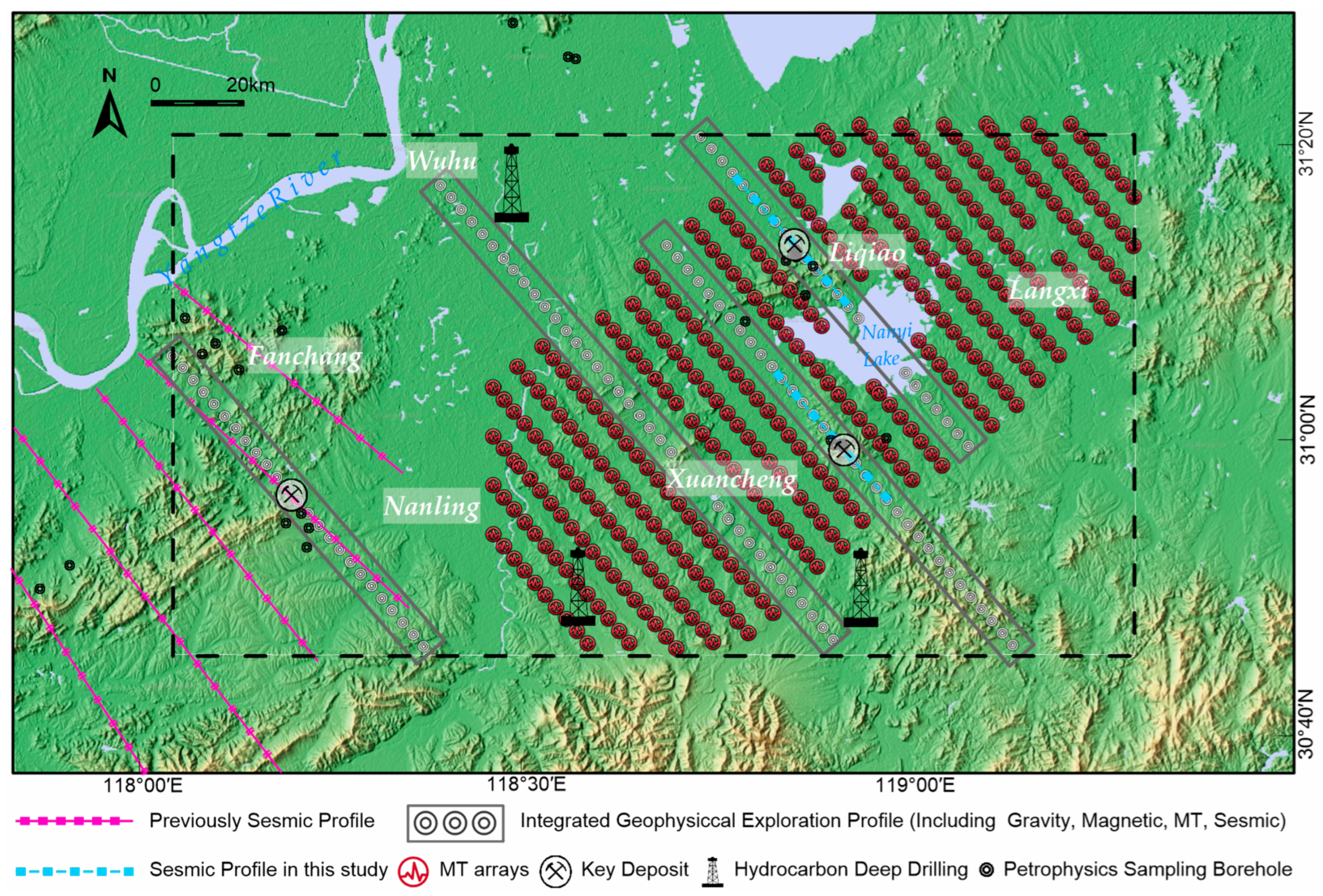
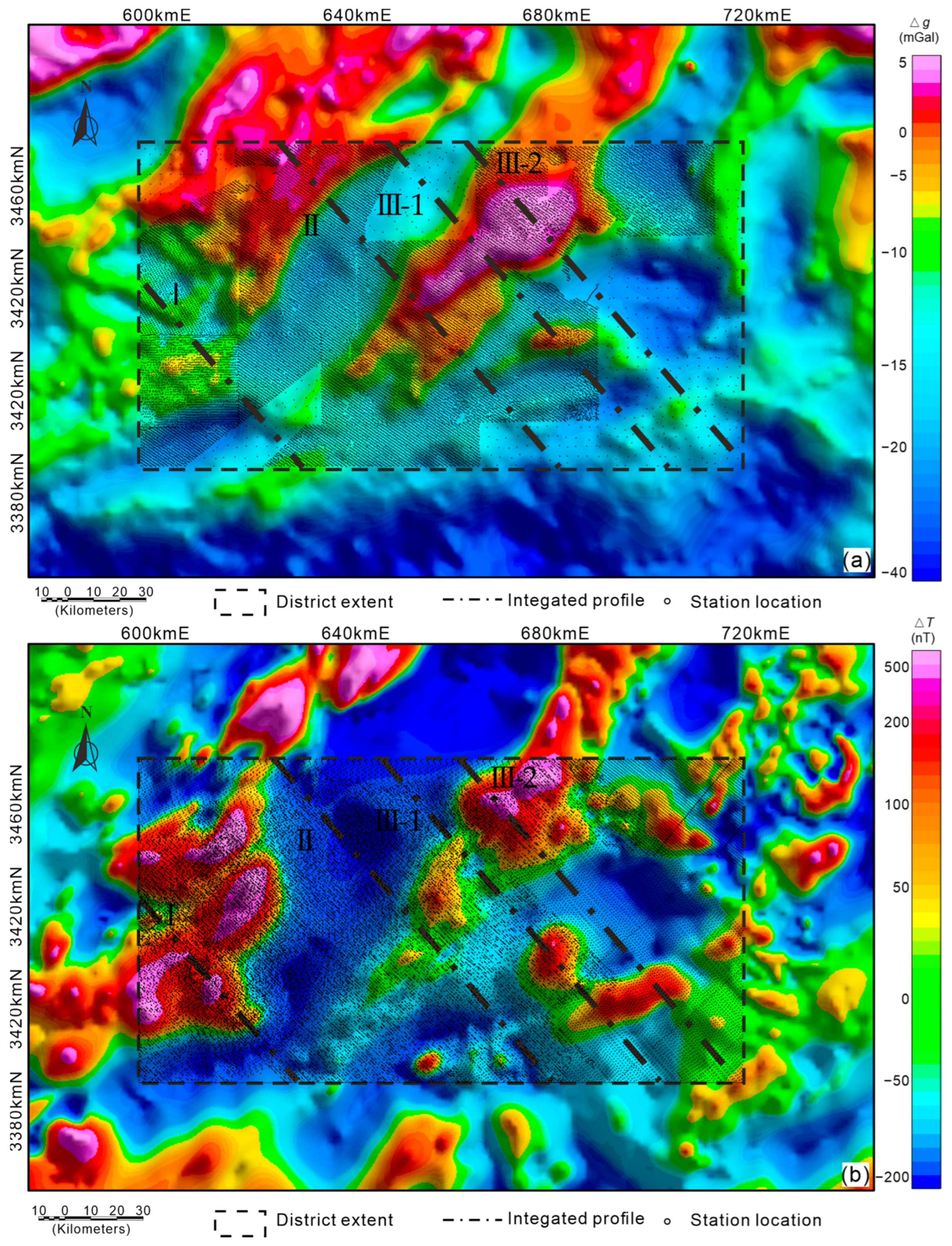

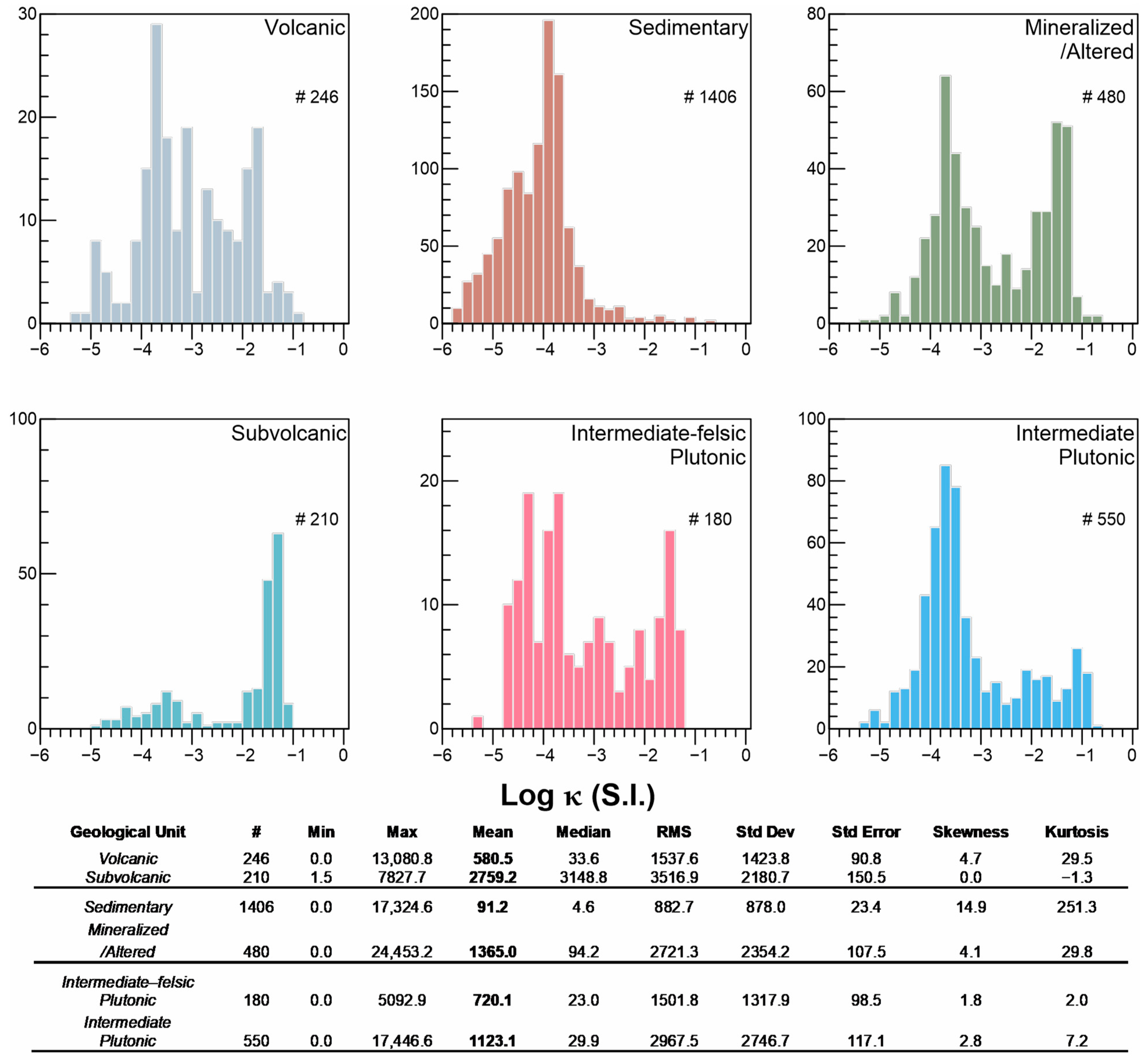




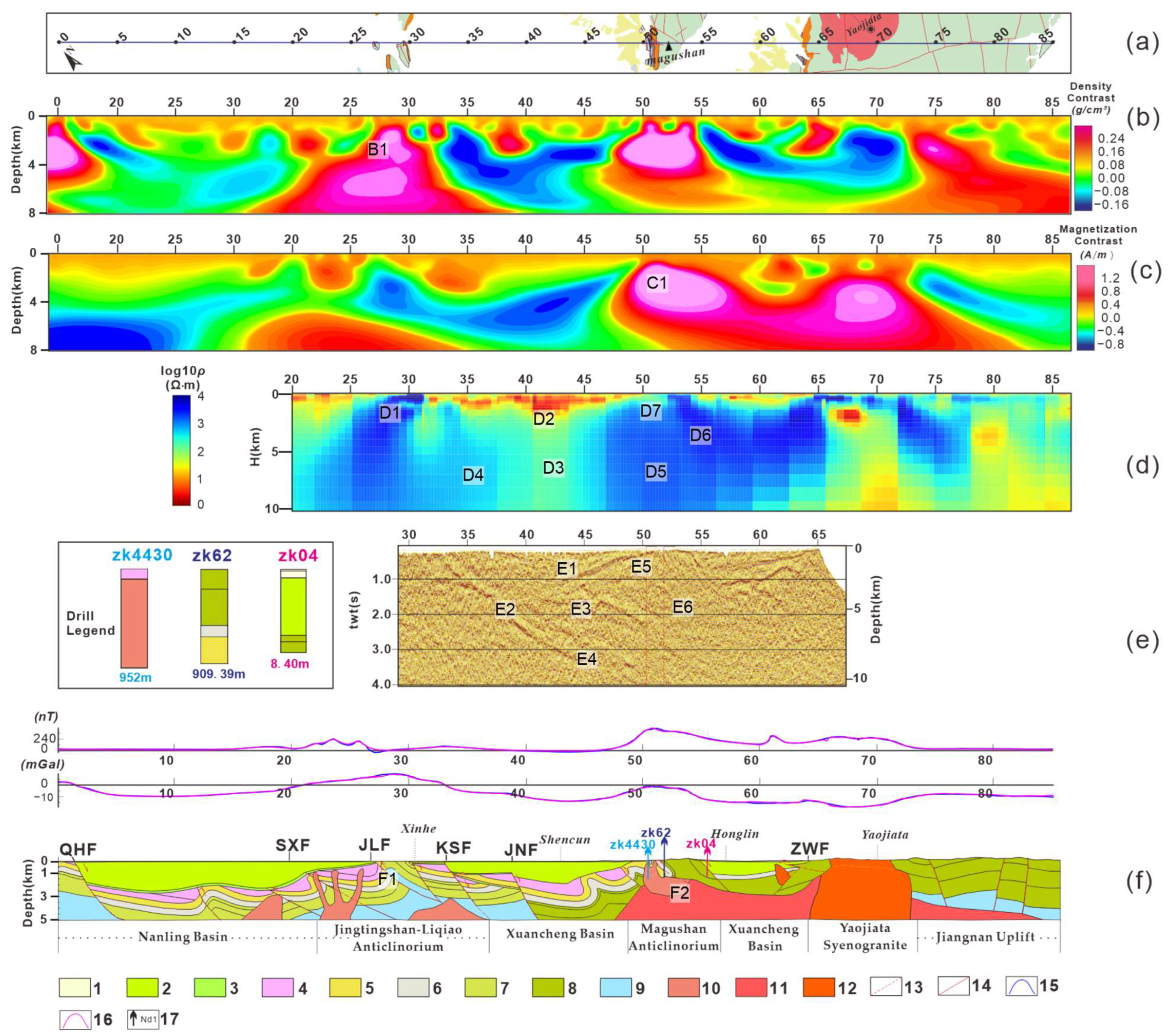

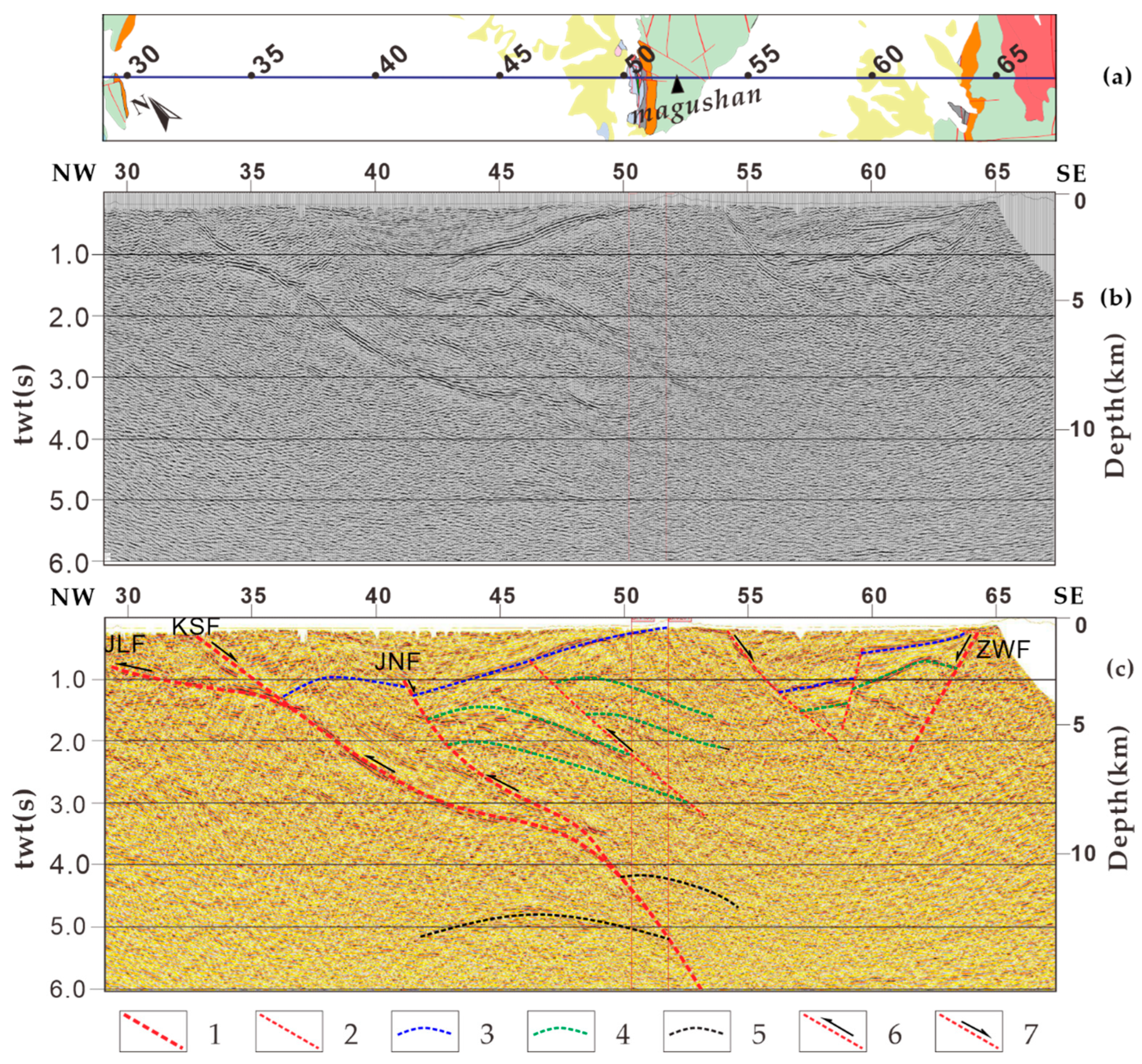
Disclaimer/Publisher’s Note: The statements, opinions and data contained in all publications are solely those of the individual author(s) and contributor(s) and not of MDPI and/or the editor(s). MDPI and/or the editor(s) disclaim responsibility for any injury to people or property resulting from any ideas, methods, instructions or products referred to in the content. |
© 2023 by the authors. Licensee MDPI, Basel, Switzerland. This article is an open access article distributed under the terms and conditions of the Creative Commons Attribution (CC BY) license (https://creativecommons.org/licenses/by/4.0/).
Share and Cite
Guo, D.; Lan, X.; Lu, S.; Zhang, Y.; Ding, W.; You, M.; Zhang, K.; Zhao, L.; Wang, Y.; Zhang, S.; et al. Deep Structure of Nanling-Xuancheng Ore District, Eastern China: Insights from Integrated Geophysical Exploration. Minerals 2023, 13, 1498. https://doi.org/10.3390/min13121498
Guo D, Lan X, Lu S, Zhang Y, Ding W, You M, Zhang K, Zhao L, Wang Y, Zhang S, et al. Deep Structure of Nanling-Xuancheng Ore District, Eastern China: Insights from Integrated Geophysical Exploration. Minerals. 2023; 13(12):1498. https://doi.org/10.3390/min13121498
Chicago/Turabian StyleGuo, Dong, Xueyi Lan, Sanming Lu, Yuanyuan Zhang, Wenxiang Ding, Miao You, Kun Zhang, Lili Zhao, Yunyun Wang, Shasha Zhang, and et al. 2023. "Deep Structure of Nanling-Xuancheng Ore District, Eastern China: Insights from Integrated Geophysical Exploration" Minerals 13, no. 12: 1498. https://doi.org/10.3390/min13121498
APA StyleGuo, D., Lan, X., Lu, S., Zhang, Y., Ding, W., You, M., Zhang, K., Zhao, L., Wang, Y., Zhang, S., Zhang, H., & Tao, L. (2023). Deep Structure of Nanling-Xuancheng Ore District, Eastern China: Insights from Integrated Geophysical Exploration. Minerals, 13(12), 1498. https://doi.org/10.3390/min13121498




